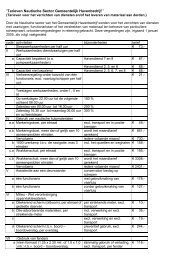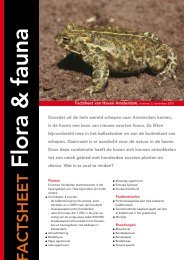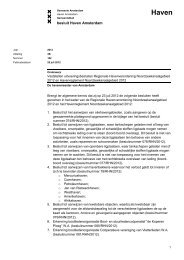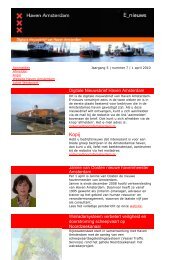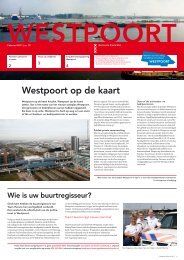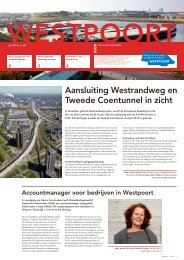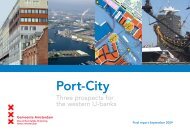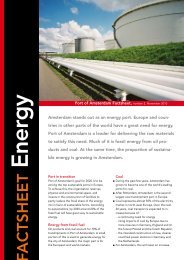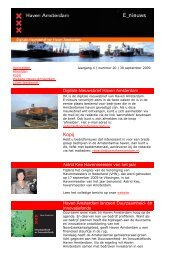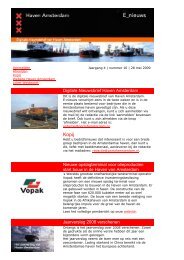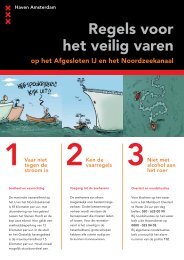Large Cruise ships to Passenger Terminal ... - Haven Amsterdam
Large Cruise ships to Passenger Terminal ... - Haven Amsterdam
Large Cruise ships to Passenger Terminal ... - Haven Amsterdam
You also want an ePaper? Increase the reach of your titles
YUMPU automatically turns print PDFs into web optimized ePapers that Google loves.
Fact sheet large cruise <strong>ships</strong> <strong>to</strong><br />
<strong>Passenger</strong> <strong>Terminal</strong> <strong>Amsterdam</strong><br />
Port of <strong>Amsterdam</strong><br />
<strong>Amsterdam</strong>-IJmond Pilot Organization<br />
2009<br />
Version: November 6 th 2009<br />
This fact sheet provides information on the passage of large cruise<br />
<strong>ships</strong> between IJmuiden Approach and <strong>Passenger</strong> <strong>Terminal</strong><br />
<strong>Amsterdam</strong>.<br />
The maximum dimensions of the cruise vessels referred <strong>to</strong> in this<br />
fact sheet are length: 340.0 meters, beam: 39.0 meters and<br />
draught: 8.80 meters.<br />
Within operational safety limits set by Port of <strong>Amsterdam</strong> and the<br />
Pilot Organization, the passage from IJmuiden Approach <strong>to</strong><br />
<strong>Passenger</strong> <strong>Terminal</strong> <strong>Amsterdam</strong> with these <strong>ships</strong> will be possible.
Content<br />
1. Request<br />
2. Summary<br />
3. Nautical aspects<br />
4. IJmuiden<br />
5. Locks<br />
6. North Sea Canal<br />
7. Turning Basins<br />
8. PTA Arrival manoeuvre<br />
9. PTA Departure manoeuvre<br />
10. Naviga<strong>to</strong>r Marginal Ships<br />
11. Wind and weather<br />
12. ETA and ETD notifications<br />
13. Overall conclusion<br />
14. Ship simula<strong>to</strong>r<br />
15. Enclosures<br />
1. Request<br />
Port of <strong>Amsterdam</strong> and the <strong>Amsterdam</strong>-IJmond Pilot Organization have received a request from<br />
<strong>Passenger</strong> <strong>Terminal</strong> <strong>Amsterdam</strong> <strong>to</strong> give their opinion on the accessibility of the terminal for large<br />
cruise <strong>ships</strong>. A study has been made based on research and on simula<strong>to</strong>r tests with a cruise ship<br />
model of: length: 340 meters, beam: 39.0 meters and draught: 8.80 meters.<br />
At the same time, the fact sheet for large cruise <strong>ships</strong> <strong>to</strong> <strong>Passenger</strong> <strong>Terminal</strong> <strong>Amsterdam</strong> has been<br />
revised. Due <strong>to</strong> dredging operations in the port of <strong>Amsterdam</strong>, <strong>Passenger</strong> <strong>Terminal</strong> <strong>Amsterdam</strong> now<br />
has better accessibility for large cruise <strong>ships</strong>, the latest data are incorporated in this revision of the<br />
fact sheet.<br />
2. Summary<br />
As long as operational safety limits set by Port of <strong>Amsterdam</strong> and the <strong>Amsterdam</strong>-IJmond Pilot<br />
Organization are adhered <strong>to</strong>, the arrival and departure of cruise <strong>ships</strong> of above mentioned<br />
dimensions <strong>to</strong> <strong>Passenger</strong> <strong>Terminal</strong> <strong>Amsterdam</strong> will be possible.<br />
On recommendation of the Pilot Organization, in late 2008 and early 2009 Port of <strong>Amsterdam</strong> carried<br />
out extensive dredging operations, during which the fairway ‘Het IJ’, turning basin ‘IJ haven’ and<br />
turning basin ‘Sumatrakade’ were widenend and deepened.<br />
3. Nautical aspects<br />
Nautical aspects of entering the IJmuiden breakwaters, the locks, the North Sea Canal<br />
(Noordzeekanaal) and <strong>Passenger</strong> <strong>Terminal</strong> <strong>Amsterdam</strong> will include the assessment of the traffic<br />
situation in relation <strong>to</strong> wind, weather and - for entering the breakwaters - the tidal current. No<br />
problems are expected, since large cruise <strong>ships</strong> have good manoeuvring characteristics and<br />
restrictions for current or wind will generally not be necessary, as long as the ship’s speed can be<br />
maintained or as long as the ship’s bow- or stern thrusters (azipods) are powerful enough <strong>to</strong><br />
manoeuvre at slow speed or <strong>to</strong> maintain position.<br />
The fairway alterations that have been carried out were based on simula<strong>to</strong>r tests for large cruise<br />
<strong>ships</strong> <strong>to</strong> <strong>Passenger</strong> <strong>Terminal</strong> <strong>Amsterdam</strong>. This research was carried out by Port of <strong>Amsterdam</strong> in<br />
cooperation with the <strong>Amsterdam</strong>-IJmond Pilot Organization in 2005 and 2006. March 2009 new<br />
simula<strong>to</strong>r tests with a cruise ship model of 340 meters length, based on the new dredged situation,<br />
have been successful.<br />
2
One of the main concerns <strong>to</strong> undertake these simula<strong>to</strong>r runs was testing the effectiveness of bow-<br />
and stern thrusters or azipods, in order <strong>to</strong> keep the ship on a straight track, and <strong>to</strong> accurately control<br />
ship movements when navigating within limited manoeuvring space along the NAP 1) -10.50 meters<br />
deep fairway ‘Het IJ’. On the 340 meters <strong>ships</strong> model, used in the simula<strong>to</strong>r, thrusters and azipods<br />
have proven <strong>to</strong> be effective up <strong>to</strong> a cross wind of 10 m/s (Beaufort scale 5) on the lateral surface of<br />
the cruise ship and squat and bank-effects were well within safe limits.<br />
4. IJmuiden<br />
All <strong>ships</strong> bound for IJmuiden and <strong>Amsterdam</strong> first have <strong>to</strong> enter the port via the IJmuiden<br />
breakwaters; the entrance is 500 meters wide. Inner breakwaters divide the entrance in<strong>to</strong> ‘Nieuwe<br />
Buitenhaven’ and ‘Oude Buitenhaven’. All shipping in the <strong>Amsterdam</strong> North Sea Canal area, including<br />
the port of <strong>Amsterdam</strong>, is regulated by the <strong>Amsterdam</strong> vessel traffic service.<br />
The main leading line, used by all <strong>ships</strong>, has a range of more than 12 nautical miles, and marks the<br />
last part of the 25 miles long approach through the deep water route, a buoyed channel <strong>to</strong> IJmuiden.<br />
Radar information and radar assistance are available.<br />
5. Locks<br />
The lock at IJmuiden, operated and managed by Port of <strong>Amsterdam</strong>, gives access <strong>to</strong> the North Sea<br />
Canal. According <strong>to</strong> the Inland Navigations Police Regulations, all <strong>ships</strong> with dimensions exceeding<br />
length 325 meters, or beam 42 meters, or draught 13.10 meters, need an exemption for the passage<br />
of the locks and North Sea Canal. This settlement normally is an agent task. The competent authority<br />
normally grants this exemption.<br />
The North Sea Canal leads up <strong>to</strong> <strong>Passenger</strong> <strong>Terminal</strong> <strong>Amsterdam</strong>, and other commercial harbour<br />
basins in the port of <strong>Amsterdam</strong>. It forms part of the network that has a direct connection with<br />
Germany via the river Rhine. Distance from the pilot station <strong>to</strong> the locks is 8 nautical miles (14.80<br />
kilometers) and takes approximately 1 hour and 15 minutes. The locking process will take about 30<br />
minutes.<br />
Dimensions Yacht lock South lock Middle lock North lock<br />
length 110 meters 120 meters 200 meters 400 meters<br />
breadth 11 meters 18 meters 25 meters 50 meters (47<br />
meters between<br />
fenders)<br />
depth 1) NAP-3.75 meters NAP-8.0 meters NAP-10.0 meters NAP-15.0 meters<br />
1)<br />
NAP: the Normaal <strong>Amsterdam</strong> Peil (NAP), is the reference level in the Netherlands which heights and depts are related <strong>to</strong>.<br />
The NAP level matches with mean sea level. (MSL)<br />
6. North Sea Canal.<br />
The dept of the North Sea Canal, up <strong>to</strong> the Mercuriushaven (bulk- and grain terminal) is NAP-15.50<br />
meters and kept at a constant water level; there are no currents and tides. The actual water level on<br />
the North sea Canal and <strong>Amsterdam</strong> port basins, related <strong>to</strong> the NAP, is 0.45 metres below NAP level.<br />
(NAP-0.45 meters) In practice this implies a dept of the North Sea Canal of 15.05 meters, fairway<br />
‘Het IJ’ and turning basins of 10.05 meters.<br />
3
Between the banks the North Sea Canal is 270 meters wide. From the Mercuriushaven <strong>to</strong> <strong>Passenger</strong><br />
<strong>Terminal</strong> <strong>Amsterdam</strong> the fairway follows the fairway ‘Het IJ’ and has several turns; this buoyed<br />
channel is 1.5 nautical miles (2.70 kilometers) long, the width at a depth of 10.00 meters varies<br />
between 118 meters and 158 meters.<br />
The distance along the North Sea Canal, from the locks <strong>to</strong> <strong>Passenger</strong> <strong>Terminal</strong> <strong>Amsterdam</strong>, is 13<br />
nautical miles (24.10 kilometers) and takes approximately 2 hours and 15 minutes.<br />
Because of the official speed regulation on the North Sea Canal, any delays encountered at earlier<br />
stages of the journey, cannot be compensated at a later stage by transiting the North Sea Canal at a<br />
higher speed.<br />
7.Turning Basins<br />
In the port of <strong>Amsterdam</strong> the North Sea Canal gradually narrows and enters the fairway ‘Het IJ’. In<br />
this area the fairway and turning basins have been dredged and widened in late 2008 and early 2009.<br />
An increased UKC and a wider fairway reduce squat and bank-effects for large cruise <strong>ships</strong> and create<br />
a safer passage. At the same time the widened fairway ‘Het IJ’ provides a safer separation between<br />
seagoing <strong>ships</strong> and inland barges and small craft.<br />
Near <strong>Passenger</strong> <strong>Terminal</strong> <strong>Amsterdam</strong> two large turning basins are laid out:<br />
- turning basin ‘IJ-haven’ opposite the <strong>Passenger</strong> <strong>Terminal</strong> <strong>Amsterdam</strong>, with a diameter<br />
- of 270 meters at an actual depth of 10.05 meters;<br />
- turning basin ‘Sumatrakade’ opposite the Sumatrakade and near the berth, with a diameter<br />
of 375 meters at an actual depth of 10.05 meters.<br />
In case of technical failure of the bow- or stern thrusters or lack of lateral propellers there is a<br />
possibility <strong>to</strong> use tug assistance <strong>to</strong> turn in the turning basins ‘IJ-haven’ or ‘Sumatrakade’. However,<br />
safety limits should be taken in<strong>to</strong> account at all times.<br />
8. PTA Arrival manoeuvre<br />
Usually, cruise <strong>ships</strong> berth port side <strong>to</strong>, bow facing west. Upon arrival, two options are available:<br />
use the turning basin ‘IJ-haven’ or the turning basin ‘Sumatrakade’ more <strong>to</strong> the east. In either case<br />
the best manoeuvre is considered <strong>to</strong> be the one turning the ship <strong>to</strong> port, with the bow turning <strong>to</strong> the<br />
north and the stern turning closing in <strong>to</strong> the ‘Sumatrakade’ (sufficient deep water). Before that, the<br />
ship will have <strong>to</strong> be accurately positioned in<strong>to</strong> the centre of the turning basin and then s<strong>to</strong>pped,<br />
before the turning-manoeuvre can be started. The use of NMS or accurate DGPS-instrument is<br />
recommended.<br />
Because during this manoeuvre the ship will completely close off the fairway ‘Het IJ’. Vessel traffic<br />
control will be carried out by Port of <strong>Amsterdam</strong> vessel traffic service. At the end of the manoeuvre,<br />
the ship will have been brought safely alongside <strong>Passenger</strong> <strong>Terminal</strong> <strong>Amsterdam</strong>.<br />
9. PTA Departure manoeuvre:<br />
Since the passenger <strong>ships</strong> will mostly be berthed bow facing west, the departure manoeuvre is<br />
considered <strong>to</strong> be quite easy.<br />
10. Naviga<strong>to</strong>r Marginal Ships:<br />
Normal GPS receivers are known <strong>to</strong> have slight position inaccuracies < 5 meters due <strong>to</strong> atmospheric<br />
disturbance, ship’s structures, clock-error, and interference from other radio signals. The pilots use<br />
4
the precise navigation system Naviga<strong>to</strong>r Marginal Ships (NMS) for navigation and docking. In most<br />
countries this system is known as a Portable Pilot Unit (PPU). This is a portable RTK-GPS receiver<br />
with 2 antennas and a local reference station (RTK-station) based on Real Time Kinematics. Via radio<br />
signals the RTK-station, placed in a precise geodetic position on land, has contact with the NMS<br />
receivers on board. The RTK-station checks GPS signals with its own reference position and transmits<br />
the corrected position <strong>to</strong> the NMS. This system has an accuracy < 0.04 meters and has proven <strong>to</strong> be a<br />
reliable navigational aid.<br />
In the future real-time data/information will be sent <strong>to</strong> the NMS, such as VTS-data (Radar, AIS),<br />
Meteo- and Hydro information. The NMS is certified by the Dutch Ministry of Transport for the use as<br />
a precise navigational instrument for deep draught <strong>ships</strong> (draught ≥14.10 meters and ≤ 17.80 meters)<br />
when piloted through the 25 miles (43 kilometers) long deep draught channel <strong>to</strong> IJmuiden.<br />
5
The NMS display is based on a certified Electronic Nautical Chart (ENC) with an adjustable scale on<br />
which the shape of the vessel is projected. The accurate position of NMS-antennas guarantees the<br />
exact ship’s position, ground course and ground speed, on the ENC. Continuous GPS/RTK data are<br />
translated in<strong>to</strong> ship’s longitudinal and transverse movements and can be visualised with vec<strong>to</strong>rs and<br />
predictions of future positions up <strong>to</strong> 1-5 minutes in advance.<br />
11. Wind and weather<br />
Prevailing winds in the Netherlands during the year are from SW <strong>to</strong> W, average 4-6 Beaufort. The<br />
berths at <strong>Passenger</strong> <strong>Terminal</strong> <strong>Amsterdam</strong> are in an East-West direction, so on most occasions <strong>ships</strong><br />
are moored with bow or stern in the wind. Summer conditions are generally better than winter<br />
conditions.<br />
Detailed predictions of wind, wind direction, wind gusts, showers and visibility are on-line available<br />
via the national weather service (KNMI); moreover, the official Hydro Meteo Centre North Sea<br />
(HMCN) provides specialised forecasts for deep draught <strong>ships</strong>. Via weather news or Schiphol Airport<br />
a detailed local forecast for the North Sea Canal area can be obtained. Port of <strong>Amsterdam</strong> will be<br />
installing an accurate wind and visibility reporting system in 2010. Via wireless connection this<br />
information will also be available <strong>to</strong> the pilot on board the ship.<br />
6
12. ETA and ETD notifications<br />
All <strong>ships</strong> with destination <strong>Amsterdam</strong> will have <strong>to</strong> pass through the IJmuiden locks upon arrival and<br />
departure. Lock planning is based on ship’s ETA and ETD. For a smooth lock passage all <strong>ships</strong> have <strong>to</strong><br />
adhere <strong>to</strong> the ETA and ETD notifications as stated by the Dutch Government.<br />
ETA Notification<br />
Who How When Remarks<br />
All <strong>ships</strong> with a draught VTS Port of <strong>Amsterdam</strong><br />
ETA-12 hours<br />
Deviations in<br />
≤14.10 and >8.00 m tel: +31(0)20 5234778<br />
IJmuiden Racon buoy ETA >30<br />
fax: +31(0)20 5234800<br />
(52°28.5’N04°23.7’E) minutes<br />
email: pivts@por<strong>to</strong>famsterdam.nl<br />
should be<br />
VHF: Traffic Center IJmuiden VHF-07 ETA-6 hours<br />
reported<br />
IJmuiden Racon buoy<br />
(52°28.5’N04°23.7’E)<br />
immediately<br />
<strong>Amsterdam</strong> Pilots<br />
tel: +31(0)255 564500<br />
fax: +31(0)255 532535<br />
email:<br />
pilots.amsterdam@loodswezen.nl<br />
ETA-3 hours<br />
IJmuiden Racon buoy<br />
(52°28.5’N04°23.7’E)<br />
ETA-1 hours<br />
IJmuiden Racon buoy<br />
(52°28.5’N04°23.7’E)<br />
ETD and Shift<br />
Notifications<br />
Who How When Remarks<br />
all <strong>ships</strong> with draught<br />
≤14.10 and ≥8.00 m<br />
VTS Port of <strong>Amsterdam</strong><br />
tel: +31(0)20 5234777<br />
fax: +31(0)20 5234800<br />
email: pivts@por<strong>to</strong>famsterdam.nl<br />
VHF: corresponding VTS-channel<br />
<strong>Amsterdam</strong> Pilots<br />
tel: +31(0)255 564500<br />
fax: +31(0)255 532535<br />
email:<br />
pilots.amsterdam@loodswezen.nl<br />
ETD-8 hours<br />
berth<br />
ETD-4 hours<br />
berth<br />
On ETD<br />
berth<br />
Deviations in<br />
ETD >30<br />
minutes<br />
should be<br />
reported<br />
immediately<br />
12. Overall conclusion<br />
Based on simula<strong>to</strong>r tests, arrivals and departures of cruise <strong>ships</strong> of dimensions: length: 340 meters,<br />
beam: 39.0 meters and draught: 8.80 meters, are possible within operational safety limits set by Port<br />
of <strong>Amsterdam</strong> and the Pilot Organization.<br />
These operational safety limits include at least:<br />
a. <strong>to</strong> avoid delays: send ETA or ETD notifications well in advance for the planning process of<br />
the locks and also for the planning of qualified and well rested pilots;<br />
b. availability and evaluation of accurate and detailed wind- and weather forecast;<br />
c. ship’s manoeuvrability in average hydro/meteo conditions (up <strong>to</strong> Beaufort 6) must be<br />
sufficient;<br />
d. the availability of assisting tugs in relation <strong>to</strong> infrastructure;<br />
e. use of pilot’s NMS-system for navigating and docking;<br />
f. availability of ship’s D-GPS system as a second main system;<br />
g. during manoeuvring in<strong>to</strong> turning basins, good communication with <strong>ships</strong> crew for distances<br />
<strong>to</strong> the quays, as backup for precision GPS-systems;<br />
7
h. following condition may be critical for arrival and departure:<br />
a. Strong winds: due <strong>to</strong> the exposed <strong>to</strong>pographic situation on the North Sea Canal and<br />
the IJmuiden locks, in relation <strong>to</strong> large lateral wind surface of large cruise <strong>ships</strong>.<br />
13. Ships simula<strong>to</strong>r<br />
The <strong>Amsterdam</strong>-IJmond Pilot Organization have their own ship simula<strong>to</strong>r, which they use <strong>to</strong> practice<br />
the passage from IJmuiden Approach <strong>to</strong> <strong>Passenger</strong> <strong>Terminal</strong> <strong>Amsterdam</strong>. Demonstrations of<br />
simula<strong>to</strong>r runs can be given <strong>to</strong> masters of passenger <strong>ships</strong>.<br />
14. Enclosures<br />
1. overview fairway ‘Het IJ’ , turning basins ‘IJ-haven’ and ‘Sumatrakade’;<br />
2. updated ENC’s;<br />
3. prints of simula<strong>to</strong>r runs.<br />
8



